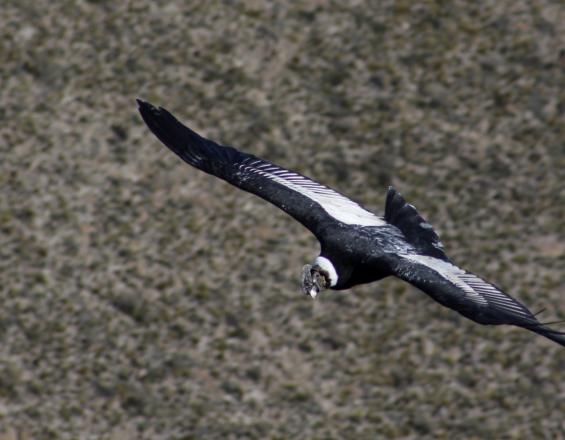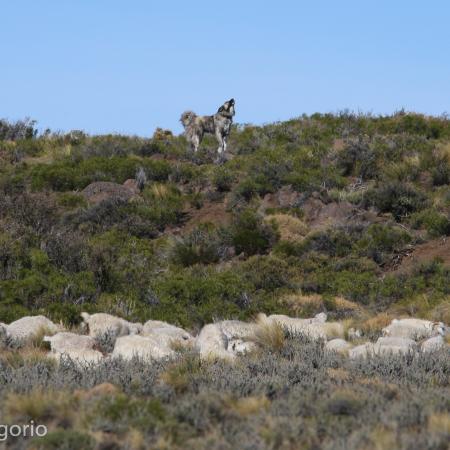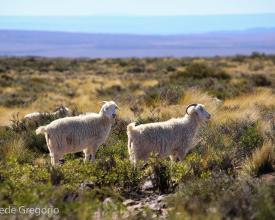
In search of coexistence between livestock and wild carnivores for the conservation of protected areas of the Patagonian steppe and the improvement of the living conditions of the producers who live there.

WCS Argentina implements non-lethal livestock management tools to control livestock predation in protected areas and peripheral zones. By working together with small producers, we achieve sustainable and wildlife-friendly production, while improving the living conditions of local communities. These producers are awarded Wildlife Friendly certification, which adds value to the product and increases its marketing potential in both the local and international markets.
Among the aforementioned tools, the use of light deterrents, improvements in corrals, and the incorporation of livestock protection dogs (PPG) have been consolidated. WCS Argentina has a PPG kennel in the city of Malargüe. Threatened species such as the Andean condor and the Andean cat often suffer reprisals from producers affected by predation, so the work of coexistence becomes fundamental for their conservation.
Context
Challenges addressed
- Achieving changes in culturally rooted livestock management methodologies in some areas.
- Incorporation and long-term maintenance of non-lethal predation control tools.
- Visualization of the socio-economic benefits of sustainable management of natural pastures.
- Increased market interest in certified products.
Location
Process
Summary of the process
- WCS Argentina and small sheep and goat producers in northern Patagonia work together to identify and mitigate conflicts that develop between livestock production and wildlife.
- Livestock producers incorporate livestock protection dogs (PPG) as a non-lethal control tool for livestock depredation by wild carnivores.
- This implementation, in addition to others related to sustainable production management, allows producers to be eligible for international Wildlife Friendly certification.
- WCS Argentina sponsors and endorses Wildlife Friendly certification, verifies compliance with the commitments assumed by producers, and permanently advises producers on the development of sustainable and wildlife-friendly production.
Building Blocks
Livestock Protection Dogs (LPP) for non-lethal predation control
PPGs avoid predator attacks without causing any damage to wildlife, since wild carnivores avoid approaching areas where they perceive the presence of these dogs. PPGs are not separated from their social group, the livestock, at any time of the day and thus provide permanent protection. When attacks on livestock cease, producers do not need to take measures against wild carnivores, which can often be disproportionate and cause enormous problems for wildlife populations.
Enabling factors
- Correct imprinting of livestock protection dog (PPG) puppies.
- Adequate maintenance of animal welfare, with particular emphasis on the correct nutrition of the PPG.
- Work on getting used to the social group (herd) to which the PPG is integrated after imprinting.
- Follow-up of the behavioral evolution of the PPG, particularly up to two years of age.
Lesson learned
- Livestock protection dogs (PPG) can be effective in reducing predator attacks from a very young age, but they must still be supervised by the producer in charge until they are two years old, at which time they reach maturity.
- Producers feel very secure having a PPG, which allows them to invest the time they used to spend caring for their animals in other matters, including recreation and cultural activities. This is why PPGs not only represent improvements in the economic aspect, but also improve the producers' standard of living.
Wildlife Friendly Certification for producers who adopt wildlife-friendly livestock management tools.
WCS Argentina sponsors the international Wildlife Friendly certification for producers who, working together with WCS, adopt sustainable and wildlife-friendly livestock management methodologies. The certification improves the marketing conditions of the products (wool and mohair), opening new markets that look for this type of materials developed in harmony with the environment, and improving sales prices. This gives the products an important added value, which has its origin in a change of paradigm for the development of a sustainable and wildlife-friendly livestock production.
Enabling factors
- Producers agree to comply with certain requirements in order to be certified.
- WCS Argentina works together with producers to enable them to meet the certification requirements.
Lesson learned
- Livestock producers value the recognition of their products, both for their quality and the way they are produced.
- The general public seeks responsible consumption. Within the textile market, Wildlife Friendly certification is highly valued and widely accepted.
- The interest in this certification, both nationally and internationally, has led many producers to become interested in improving their livestock management in order to be eligible.
Impacts
- Decrease in hunting of wild carnivores as control and retaliation for livestock depredation.
- Improvement of natural pastures and the relationship between producers and wild herbivores.
- Incorporation of more than 40,000 hectares to the public domain of lands that are part of the La Payunia Provincial Reserve, Province of Mendoza. Removal of domestic livestock from these areas.
- Reduction of livestock losses due to depredation, reducing the loss of capital. This is particularly relevant for small producers, since losses due to depredation can reach more than 20% per year.
- Improved community welfare and its relationship with the environment.
- Improved marketing, demand and sales prices for natural fibers (wool and mohair) certified Wildlife Friendly.
- Involvement of governmental entities in strategies to promote coexistence for improvements in livestock management, with a view to establishing them as public policies.
- Raising awareness among society in general about the importance of coexistence between livestock production and wildlife through newspaper articles and social networks.
Beneficiaries
- Small sheep and goat producers.
- Local textile artisans.
- Populations of carnivores and wild scavengers.
- Patagonian steppe environment.
Sustainable Development Goals
Story

Small ranchers in northern Patagonia live in close contact with wildlife, and often suffer the consequences of this interaction. By learning about their daily reality, one can understand why they react to wild carnivores...many times in a single attack by a predator (e.g. puma) they can lose more than 10% of their production. But what is pleasantly surprising is that when they discover new ways of production, using wildlife-friendly management methodologies, there is no turning back...they become defenders and guardians of the environment they live in and the wildlife they share it with. They begin to value the ecological role of the animals that previously mortified them, and discover that they are part of something much bigger and more significant, that benefits them in every possible way, socially, economically and even spiritually....
Seeing this transformation firsthand is very gratifying, and gives meaning to conservation that includes humans as part of the environment to be protected.






